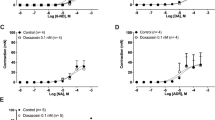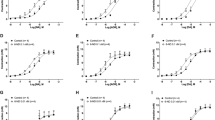Abstract
In order to assess the consequences of a concomitant blockade of P2X-receptors and ecto-nucleotidases, effects of 13 P2-receptor antagonists were investigated on contractions of the rat vas deferens elicited by α,β-methylene ATP (α,β-MeATP) and ATP and on the removal of ATP from the incubation medium by vas deferens tissue.
Increasing concentrations of all antagonists reduced and finally abolished contractions elicited by α,β-MeATP (3 μM), with IC50-values ranging from 1.1 to 100 μM. Pyridoxalphosphate-6-azophenyl-2’,4’-disulphonate (PPADS), 6-azophenyl-4-amino-5-hydroxy-naphthalene-1,3-disulphonate (NH02), 4,4’-diisothiocyanatostilbene-2,2’-disulphonate (DIDS) and uniblue A also progressively reduced and finally abolished contractions elicited by ATP (1 mM). 8,8’-[Carbonylbis(imino-3,1-phenylenecarbonyl-imino)]-bis-(1,3,5-naphthalenetrisulphonate) (NF023), sura- min, pyridoxalphosphate-6-azophenyl-2’,5’-disulphonate (iso-PPADS), trypan blue and reactive blue 19, in contrast, caused only partial blockade, by 34–43% maximally; reactive blue 2 and reactive red 2 had no effect; and 6,6’-(1,1’-biphenyl-4,4’-diylbisazo)-bis-4-amino-5-hydroxy-naphtha-lene-1,3-disulphonate (NH01) and Evans blue even enhan- ced the response to ATP. For antagonists causing full or partial inhibition, the IC50-values against ATP were close to those against α,β-MeATP. All antagonists attenuated the removal of ATP, with IC25%-values ranging from 0.8 μM to >320 μM.
The results confirm the frequent combination, in one antagonist molecule, of P2-receptor blockade and blockade of ecto-nucleotidases. This dual action underlies the effect of such compounds on contractions of the vas deferens elicited by ATP which, for certain substances (e.g., suramin, reactive blue 2), can be explained by a simple model in which the antagonist simultaneously blocks the degradation of ATP and a single contraction-mediating receptor (P2X1). Several observations, however, do not conform with this model, and the existence of multiple contraction-mediating receptors for ATP or multiple, pharmacologically distinct ecto-nucleotidases has to be considered.
Similar content being viewed by others
Author information
Authors and Affiliations
Additional information
Received: 23 October 1998 / Accepted: 11 January 1999
Rights and permissions
About this article
Cite this article
Bültmann, R., Trendelenburg, M., Tuluc, F. et al. Concomitant blockade of P2X-receptors and ecto-nucleotidases by P2-receptor antagonists: functional consequences in rat vas deferens. Naunyn-Schmiedeberg's Arch Pharmacol 359, 339–344 (1999). https://doi.org/10.1007/PL00005360
Issue Date:
DOI: https://doi.org/10.1007/PL00005360




